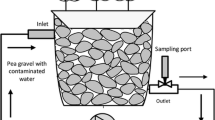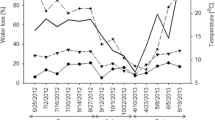Abstract
A rarely used hydroponic plant root mat filter (PRMF, of 6 m2) and a horizontal subsurface flow constructed wetland (HSSF CW, of 6 m2), operating in continuous flow and discontinuous outflow flushing modes, were investigated for treating sulfate-rich and organic carbon-lean groundwater contaminated with monochlorobenzene (MCB); 1,2-dichlorobenzene (1,2-DCB); 1,4-dichlorobenzene (1,4-DCB); and 2-chlorotoluene. Whereas the mean inflow loads ranged from 1 to 247 mg m−2 days−1, the range of mean inflow concentrations of the chlorobenzenes recorded over a period of 7 months was within 0.04 and 8 mg L−1. A hydraulic surface loading rate of 30 L m−2 days−1 was obtained in both systems. The mean load removal efficiencies were found to vary between 87 and 93 % in the PRMF after a flow path of 4 m, while the removal efficiencies were found to range between 46 and 70 % and 71 to 73 % in the HSSF CW operating in a continuous flow mode and a discontinuous outflow flushing mode, respectively. Seasonal variations in the removal efficiencies were observed for all low-chlorinated hydrocarbons both in the PRMF and the HSSF CW, whereby the highest removal efficiencies were reached during the summer months. Sulfide formation occurred in the organic carbon-lean groundwater particularly in summer, which is probably due to the plant-derived organic carbon that fostered the microbial dissimilatory sulfate reduction. Higher redox potential in water was observed in the PRMF. In conclusion, the PRMF could be an option for the treatment of water contaminated with compounds which in particular need oxic conditions for their microbial degradation, such as in the case of low-chlorinated benzenes.






Similar content being viewed by others
References
Braeckevelt M, Rokadia H, Imfeld G, Stelzer N, Paschke H, Kuschk P, Kästner M, Richnow H-H, Weber S (2007a) Assessment of in situ biodegradation of monochlorobenzene in contaminated groundwater treated in a constructed wetland. Environ Pollut 148:428–437
Braeckevelt M, Rokadia H, Mirschel G, Weber S, Imfeld G, Stelzer N, Kuschk P, Kästner M, Richnow HH (2007b) Biodegradation of chlorobenzene in a constructed wetland treating contaminated groundwater. Water Sci Technol 56:57–62
Braeckevelt M, Mirschel G, Wiessner A, Rueckert M, Reiche N, Vogt C, Schultz A, Paschke H, Kuschk P, Kaestner M (2008) Treatment of chlorobenzene-contaminated groundwater in a pilot-scale constructed wetland. Ecol Eng 33:45–53
Braeckevelt M, Reiche N, Trapp S, Wiessner A, Paschke H, Kuschk P, Kaestner M (2011a) Chlorobenzene removal efficiencies and removal processes in a pilot-scale constructed wetland treating contaminated groundwater. Ecol Eng 37:903–913
Caselles-Osorio A, García J (2007) Impact of different feeding strategies and plant presence on the performance of shallow horizontal subsurface-flow constructed wetlands. Sci Total Environ 378:253–262
Chen Z, Kuschk P, Reiche N, Borsdorf H, Kästner M, Köser H (2012a) Comparative evaluation of pilot scale horizontal subsurface-flow constructed wetlands and plant root mats for treating groundwater contaminated with benzene and MTBE. J Hazard Mater 209–210:510–515
Chen Z, Wu S, Braeckevelt M, Paschke H, Kästner M, Köser H, Kuschk P (2012b) Effect of vegetation in pilot-scale horizontal subsurface flow constructed wetlands treating sulphate rich groundwater contaminated with a low and high chlorinated hydrocarbon. Chemosphere 89:724–731
Dornelas FL, Machado MB, von Sperling M (2009) Performance evaluation of planted and unplanted subsurface-flow constructed wetlands for the post-treatment of UASB reactor effluents. Water Sci Technol 60:3025–3033
Faulwetter JL, Gagnon V, Sundberg C, Chazarenc F, Burr MD, Brisson J, Camper AK, Stein OR (2009) Microbial processes influencing performance of treatment wetlands: a review. Ecol Eng 35:987–1004
Field J, Sierra-Alvarez R (2008) Microbial degradation of chlorinated benzenes. Biodegradation 19:463–480
Headley TR, Tanner CC (2012) Constructed wetlands with floating emergent macrophytes: an innovative stormwater treatment technology. Crit Rev Environ Sci Technol 42:2261–2310
Jackson WA, Pardue JH (1999) Natural attenuation case study for chlorobenzenes in a forested wetland. In: Means JL, Hinchee RE (eds) Wetlands and remediation: an international conference. Batelle Press, Columbus (OH), USA, Salt Lake City, pp 9–16
Kadlec RH, Reddy KR (2001) Temperature effects in treatment wetlands. Water Environ Res 73:543–557
Kadlec RH, Wallace S (2009) Treatment wetlands, 2nd edn. CRC Press, Boca Raton, USA
Kaschl A, Vogt C, Uhlig S, Nijenhuis I, Weiss H, Kästner M, Richnow HH (2005) Isotopic fractionation indicates anaerobic monochlorobenzene biodegradation. Environ Toxicol Chem 24:1315–1324
Kästner M, Fischer A, Nijenhuis I, Geyer R, Stelzer N, Bombach P, Tebbe CC, Richnow HH (2006) Assessment of microbial in situ activity in contaminated aquifers. Eng Life Sci 6:234–251
Keefe SH, Barber LB, Runkel RL, Ryan JN (2004) Fate of volatile organic compounds in constructed wastewater treatment wetlands. Environ Sci Technol 38:2209–2216
Leppich J, Pardue JH, Jackson WA (1999) Plant-air partitioning of chlorobenzenes in wetland vegetation at a superfund site. In: Means JL, Hinchee RE (eds) Wetlands and remediation: an international conference. Batelle Press, Columbus (OH), USA, Salt Lake City, pp 17–24
Liang XM, Howlett MR, Nelson JL, Grant G, Dworatzek S, Lacrampe-Couloume G, Zinder SH, Edwards EA, Lollar BS (2011) Pathway-dependent isotope fractionation during aerobic and anaerobic degradation of monochlorobenzene and 1,2,4-trichlorobenzene. Environ Sci Technol 45:8321–8327
Liang XM, Devine CE, Nelson J, Lollar BS, Zinder S, Edwards EA (2013) Anaerobic conversion of chlorobenzene and benzene to CH4 and CO2 in bioaugmented microcosms. Environ Sci Technol 47:2378–2385
MacLeod CJA, Reid BJ, Semple KT (1999) The fate of chlorinated chlorinated benzenes in a reed-bed system. In: Leeson A, Alleman BC (eds) Phytoremediation and innovative strategies for specialized remedial applications: the fifth international in situ and on-site bioremediation symposium. Batelle Press, Columbus (OH), USA, San Diego (CA)
Matamoros V, García J, Bayona JM (2005) Behavior of selected pharmaceuticals in subsurface flow constructed wetlands: a pilot-scale study. Environ Sci Technol 39:5449–5454
Miller PL, Vasudevan D, Gschwend PM, Roberts AL (1998) Transformation of hexachloroethane in a sulfidic natural water. Environ Sci Technol 32:1269–1275
Pardue JH, Kassenga G, Shin WS (1999) Design approaches for chlorinated VOC treatment wetland. In: Means JL, Hinchee RE (eds) Wetlands and remediation: an international conference. Batelle Press, Columbus (OH), USA, Salt Lake City, Utah, pp 301–308
Pedescoll A, Corzo A, Alvarez E, Puigagut J, Garcia J (2011) Contaminant removal efficiency depending on primary treatment and operational strategy in horizontal subsurface flow treatment wetlands. Ecol Eng 37:372–380
Petelet-Giraud E, Negrel P, Gourcy L, Schmidt C, Schirmer M (2007) Geochemical and isotopic constraints on groundwater—surface water interactions in a highly anthropized site. The Wolfen/Bitterfeld megasite (Mulde subcatchment, Germany). Environ Pollut 148:707–717
Smith, M.P., Kalin, M. (2000) Floating wetland vegetation covers for suspended solids removal, treatment wetlands for water quality improvement. CH2MHILL, Quebec, Canada.
Song H-L, Li X-N, Lu X-W, Inamori Y (2009) Investigation of microcystin removal from eutrophic surface water by aquatic vegetable bed. Ecol Eng 35:1589–1598
Stottmeister U, Wießner A, Kuschk P, Kappelmeyer U, Kästner M, Bederski O, Müller RA, Moormann H (2003) Effects of plants and microorganisms in constructed wetlands for wastewater treatment. Biotechnol Adv 22:93–117
USEPA (2002) Office of water (4606), EPA 816-F-01-007. DC, Washington, National Primary Drinking Water Standards
Van de Moortel A, Meers E, De Pauw N, Tack F (2010) Effects of vegetation, season and temperature on the removal of pollutants in experimental floating treatment wetlands. Water Air Soil Pollut 212:281–297
Vogt C, Alfreider A, Lorbeer H, Ahlheim J, Feist B, Boehme O, Weiss H, Babel W, Wuensche L (2002) Two pilot plant reactors designed for the in situ bioremediation of chlorobenzene-contaminated ground water: hydrogeological and chemical characteristics and bacterial consortia. Water, Air and Soil Pollut: Focus 2:161–170
Vymazal J (2009) The use of constructed wetlands with horizontal sub-surface flow for various types of wastewater. Ecol Eng 35:1–17
Vymazal J, Masa M (2003) Horizontal sub-surface flow constructed wetland with pulsing water level. Water Sci Technol 48:143–148
Zeng T, Ziegelgruber KL, Chin YP, Arnold WA (2011) Pesticide processing potential in prairie pothole porewaters. Environ Sci Technol 45:6814–6822
Zeng T, Chin YP, Arnold WA (2012) Potential for abiotic reduction of pesticides in prairie pothole porewaters. Environ Sci Technol 46:3177–3187
Acknowledgments
This work was supported by the Helmholtz Centre for Environmental Research—UFZ within the scope of the SAFIRA II Research Program and by the European Union (European Commission, FP7 Contract No. 265946, Minotaurus), and also by the fundamental research funds for the central universities (Program No. 52902–0900206160). The authors are grateful to J. Ahlheim, S. Täglich, O. Thiel, and A. S. Al-Dahoodi for their assistance in the field and laboratory.
Author information
Authors and Affiliations
Corresponding author
Additional information
Responsible editor: Gerald Thouand
Electronic supplementary material
Below is the link to the electronic supplementary material.
Appendix 1
Schematic representation of plant root mat filter (PRMF) and horizontal subsurface flow constructed wetland (HSSF CW) (PNG 1992 kb)
Appendix 2
Loads of 1,2-DCB (related to the flow distance and depth) in the HSSF CW and the PRMF, whereby the HSSF CW was operated in a continuous flow mode from May 11th to July 20th, and in a discontinuous outflow flushing mode from August 3rd to November 8th; for each period n = 6 (JPEG 1039 kb)
Appendix 3
Loads of 1,4-DCB (related to the flow distance and depth) in the HSSF CW and the PRMF, whereby the HSSF CW was operated in a continuous flow mode from May 11th to July 20th, and in a discontinuous outflow flushing mode from August 3rd to November 8th; for each period n = 6 (JPEG 987 kb)
Appendix 4
Loads of 2-chlorotoluene (related to the flow distance and depth) in the HSSF CW and the PRMF, whereby the HSSF CW was operated in a continuous flow mode from May 11th to July 20th, and in a discontinuous outflow flushing mode from August 3rd to November 8th; for each period n = 6 (JPEG 981 kb)
Rights and permissions
About this article
Cite this article
Chen, Z., Kuschk, P., Paschke, H. et al. The dynamics of low-chlorinated benzenes in a pilot-scale constructed wetland and a hydroponic plant root mat treating sulfate-rich groundwater. Environ Sci Pollut Res 22, 3886–3894 (2015). https://doi.org/10.1007/s11356-014-3618-9
Received:
Accepted:
Published:
Issue Date:
DOI: https://doi.org/10.1007/s11356-014-3618-9




